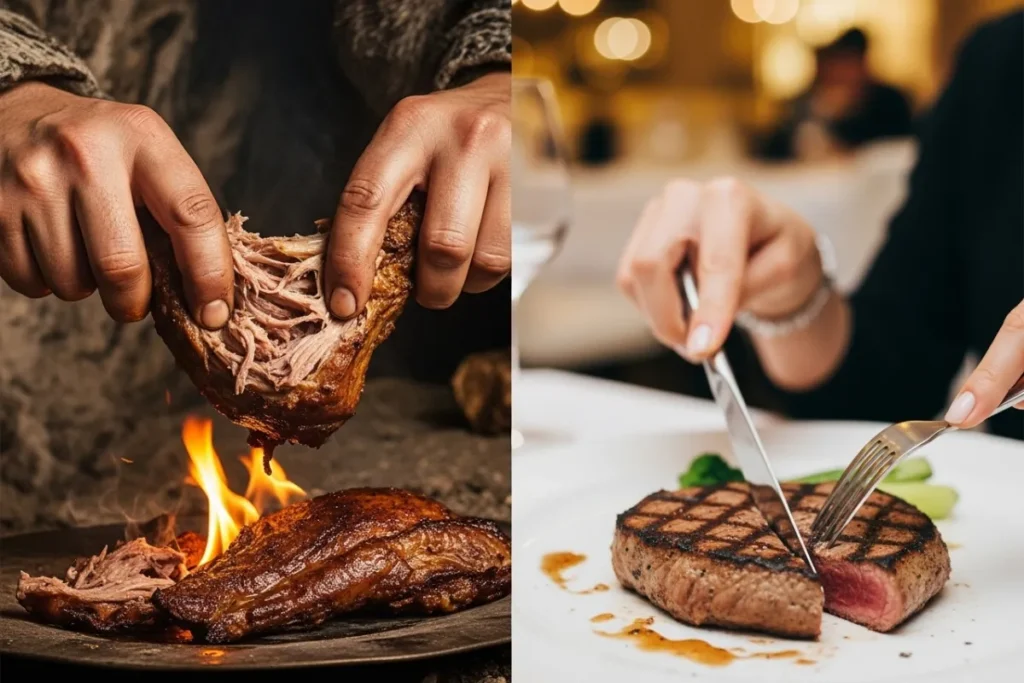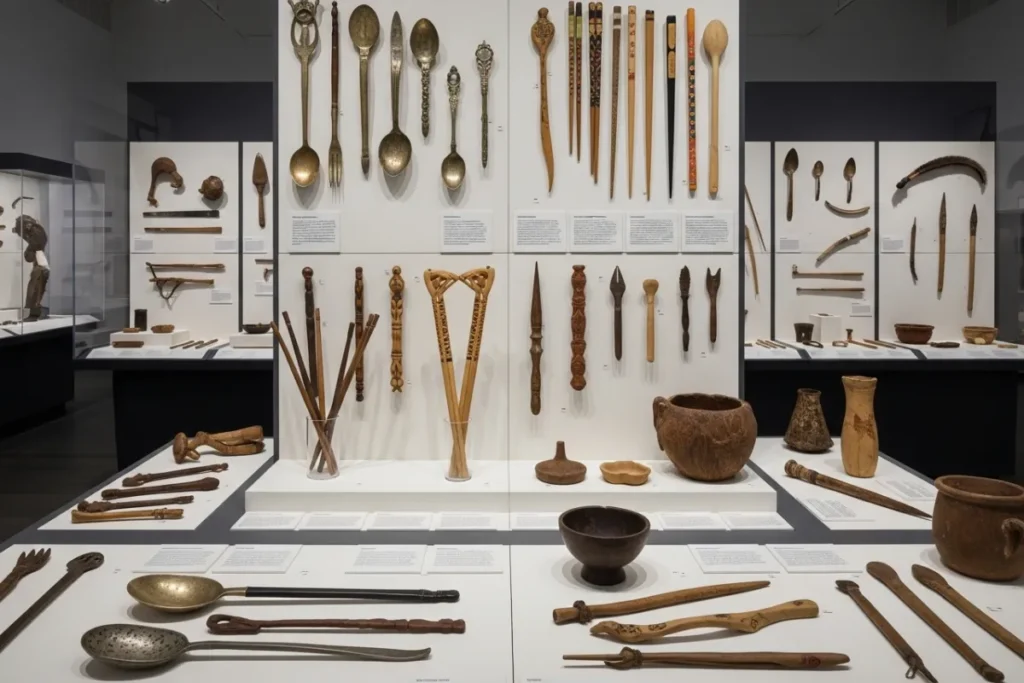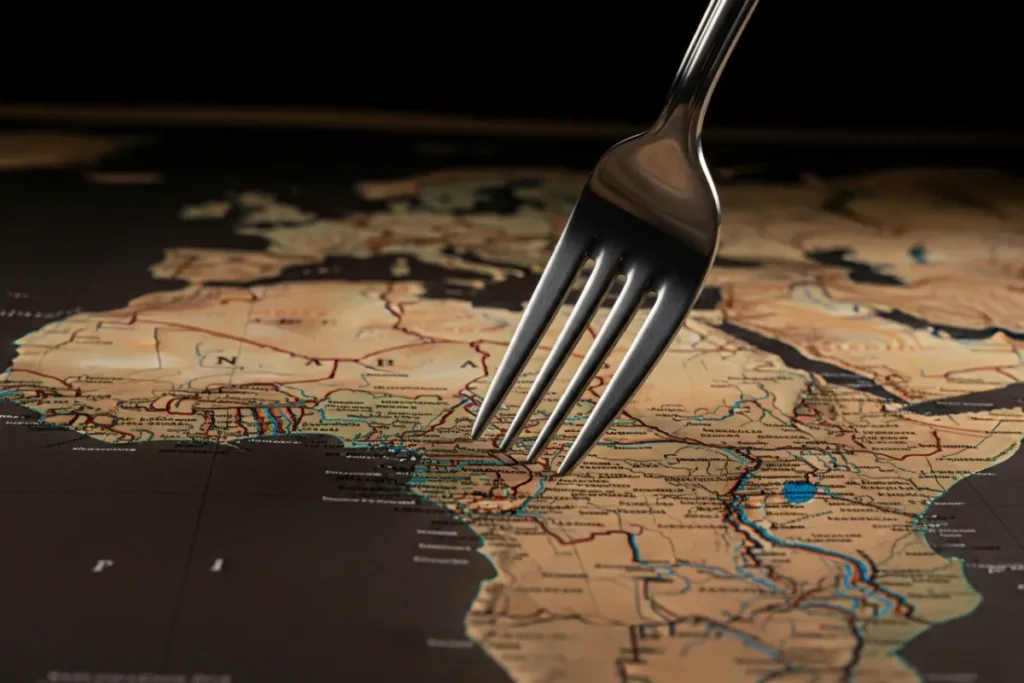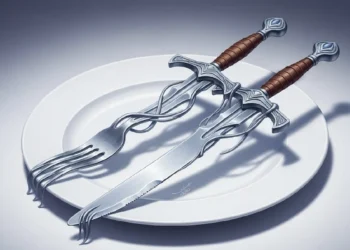Explore the rich history and evolution of cutlery”Fork and Knife”, focusing on forks and knives as symbols of civilization and dining etiquette. This blog delves into their origins, cultural significance, and transformation from survival tools to essential dining instruments. Understand how these utensils reflect societal values, social hierarchies, and cultural practices worldwide, from ancient civilizations to modern dining experiences. Discover the role of cutlery in shaping social interactions and contemporary culinary aesthetics, and the enduring legacy of forks and knives in today’s society.
Table of Contents
Introduction to Cutlery: A Brief History
The history of cutlery, particularly Fork and Knife, is a fascinating journey that reflects the evolution of human civilization and societal norms. Initially, these instruments emerged as rudimentary tools designed for basic survival tasks such as hunting and food preparation. In ancient cultures, knives often served multiple purposes, including being used as weapons or tools for crafting. The utility of these items underscored their importance in early human life, offering insight into the daily routines and lifestyle of our ancestors.
The transition from basic cutting instruments to refined cutlery symbols can be traced back to significant cultural developments. During the Roman Empire, knives played a central role in dining but forks were largely absent from the table. Romans typically utilized their knives to manipulate food effectively, showcasing their craftsmanship in design and functionality. However, as society progressed into the Middle Ages, forks began to appear in Europe, first introduced as a luxury item and gradually becoming essential dining tools. This transformation was not merely about practicality; it represented a shift in social etiquette and norms surrounding shared meals.
The Fork: From Gaiety to Utility
The fork, an instrument often taken for granted in contemporary dining, possesses a rich history marked by societal and cultural evolution. Originating from the Mediterranean region, the fork made its first notable appearances in the Byzantine Empire around the 4th century. Initially, it served as a tool for serving food rather than for direct consumption. Its transition to a dining utensil in Europe, however, was slow and marked by a struggle against cultural norms and perceptions. Many Europeans considered the fork unnecessary, opting instead for fingers or spoons to consume their meals.
The fork’s introduction into European dining was often met with resistance. It wasn’t until the late 16th century that the fork began to gain wider acceptance in Italy, thanks in part to the influence of the Italian aristocracy. Italian nobility showcased the fork as an implement of refinement, contributing to its association with sophistication and high social status. As the fork began to spread across the continent, it was not just a utensil but a symbol of civilization and decorum. The shift from using bare hands or three-pronged sticks for eating to adopting the fork epitomized a movement towards what was deemed civilized dining practices, setting standards for etiquette among the upper classes.

Knives: Tools of Survival to Symbols of Order
Throughout history, knives have played an integral role in human survival and development. Initially crafted from stone, metal, and wood, these versatile tools began as essential implements for hunting, gathering, and self-defense. As societies evolved, so did the design and usage of knives, transitioning from rudimentary survival tools to essential utensils in the dining practices of civilized communities. This evolution underscores not only the adaptability of knives but also their deep-seated association with social stratification and order.
In early civilizations, knives prominently featured in daily activities, serving practical purposes such as food preparation and protection. As populations grew and social structures became more complex, the role of knives began to shift. The transformation of the knife from a tool of necessity to an implement of refinement coincided with the emergence of dining etiquette and opulent feasts. In elite dining settings, the knife takes on a new symbolism, representing dominance, status, and power within social hierarchies.
The incorporation of knives into formal dining rituals illustrates their cultural significance and power dynamic. In many cultures, the knife has retained a dual identity; it is both a practical utensil and a symbol of authority. For instance, in Western culture, the knife often signifies control and is regarded as an essential component of table settings among the affluent. As dining customs progressed, the presence of knives at the table signified not only the affluence of the hosts but also the civility and decorum expected from guests.
Similarly, knives find representation in various cultural narratives, often depicted in literature, folklore, and art as instruments reflecting not just functionality but also the moral complexities of dominance and violence. From ancient gory battles to modern culinary artistry, the knife persists as a reminder of humanity’s precarious balance between survival, power, and order. As societies continue to evolve, the knife remains an enduring symbol of civilization, encapsulating the dualities of nurturing and destruction.
The Evolution of Dining Etiquette
The evolution of dining etiquette is a fascinating lens through which one can observe the development of civilization, particularly concerning the use of cutlery. The fork and knife, two fundamental tools of dining, have undergone significant transformation not only in their design but also in the associated rituals and social rules that dictate their use. From the early methods of eating with fingers to the introduction of sophisticated cutlery, dining practices have evolved to reflect both personal and societal values.
Initially, meals were informal gatherings where etiquette was largely non-existent. As societies progressed, particularly in Europe during the Middle Ages, cutlery began to symbolize status and sophistication. Nobility started to adopt the fork and knife, leading to a more refined dining experience characterized by specific rituals. For instance, the act of using a fork to lift food was initially met with resistance, as many considered it unnecessary and even extravagant. However, over time, the acceptance of these utensils signified increased civility and a shift toward order in dining, aligning with broader cultural changes emphasizing grace and decorum.
The rules governing dining etiquette continued to evolve through the centuries, influenced by social hierarchies and class distinctions. In the Renaissance and the following periods, structured meal courses were established, prompting more elaborate usage of cutlery. Different types of Fork and Knife emerged, designated for specific dishes, which further emphasized the sophistication of the dining experience and the class of the individuals involved. As dining became a more formal event, the rules surrounding the use of these tools became increasingly strict, highlighting the significance of appearance and behavior in social settings.
In contemporary society, while the fork and knife remain essential dining tools, the rituals have simplified somewhat. However, the underlying symbols of civilization and dominance persist. The etiquette surrounding dining demonstrates how cutlery serves not merely functional purposes, but also as reflections of social status, cultural values, and ultimately, the evolution of human interactions in communal settings.

Cutlery and Social Dynamics
The introduction of Fork and Knife into culinary practices has significantly influenced social interactions and hierarchies. Historically, the adoption of these utensils marked a pivotal shift from communal eating, where food was shared directly from common dishes, to individual servings that necessitated the use of specific tools. This transition had profound implications for social structures, illustrating the delicate interplay between cutlery, social class, and dining etiquette.
In formal dining settings, Fork and Knife have come to symbolize sophistication and culture. The transition towards their use often delineated social classes—those who employed these utensils signaled a departure from more rudimentary forms of eating, suggesting refinement and a higher social status. The act of dining with cutlery not only underscores individualism, wherein each person has a designated space and food portion but also reinforces a formality that can create an atmosphere of exclusivity. In this regard, cutlery serves both as a medium of inclusion within elite circles and as a marker of exclusion for those perceived to lack the necessary etiquettes or means.
Conversely, in communal dining environments, the absence of Fork and Knife often reveals a more egalitarian approach to meals where interactions become less strained by the formalities imposed by cutlery. In these settings, food becomes a communal experience that emphasizes connection and shared culture over the matters of class. However, the use of cutlery can still arise in cultural contexts even within shared dining practices, demonstrating its versatile role in mediating social dynamics.
Ultimately, the fork and knife encapsulate much more than mere tools for eating; they reflect underlying societal values and norms that harbor implications for inclusion and exclusion among various social classes. Understanding these dynamics provides valuable insights into how cutlery shapes our dining experiences and social interactions.
Global Perspectives: Cutlery Around the World
The use of Fork and Knife is deeply embedded in the dining traditions of various cultures, reflecting not only culinary practices but also societal values and norms. In many Western countries, the fork and knife are considered essential tools for dining. Here, the fork serves as a symbol of civility, while the knife represents control and dominance over one’s meal. The etiquette surrounding their use can often determine one’s social standing, as proper technique in holding and using these utensils can reflect personal refinement and cultural sophistication.
In contrast, cultures in Asia showcase a different relationship with dining cutlery. In countries like China and Japan, chopsticks predominately replace forks and knives, signaling a distinct culinary heritage. The act of using chopsticks is steeped in history, with ancient philosophies emphasizing harmony and balance. In this context, forks and knives may be viewed as symbols of Western influence, often reserved for specific occasions rather than everyday meals. This divergence illustrates how dining tools are not merely functional but deeply symbolic of the values and customs inherent within each society.
Moreover, in countries such as Ethiopia, communal dining practices further alter the significance of Fork and Knife. Meals are often enjoyed using injera, a type of sourdough flatbread, which serves as both a plate and utensil. The absence of separate cutlery in such contexts fosters a sense of community and shared experience, highlighting the collective over the individual. This cultural practice exemplifies how cutlery, including forks and knives, can signify broader social norms and approaches to dining.
Therefore, as we traverse the globe, the fork and knife reveal unique perspectives shaped by cultural influences, transforming these ordinary objects into profound symbols of civilization and societal values.

The Role of Forks and Knives in Contemporary Life
In today’s modern kitchen, Fork and Knife have evolved beyond their primary functions as mere eating utensils; they serve as significant symbols of culinary culture and innovation. Contemporary dining experiences are increasingly shaped by the aesthetic and functional qualities of cutlery, reflecting broader trends in design and consumer preferences. The modern fork and knife are not merely tools but instead embody the intersection of art and utility, influencing how we engage with food and dining rituals.
Recent trends in cutlery design emphasize clean lines, ergonomic shapes, and sustainable materials. Manufacturers have responded to the growing consumer demand for environmentally friendly products by incorporating biodegradable or recycled materials into their cutlery designs. This shift not only promotes sustainability but also enhances the dining aesthetic, allowing modern fork and knife sets to appeal to both functionality and visual appeal. The integration of technology in manufacturing processes has also led to innovative designs that prioritize not just style but practical usage, making meals more enjoyable and accessible.
Additionally, contemporary dining experiences often embrace a global fusion of culinary traditions, which is reflected in the diverse cutlery options available today. For instance, some households opt for specialized knives and forks that cater to particular cuisines, such as sushi knives for Japanese dishes or steak knives designed for high-quality meats. This variety allows individuals to explore different culinary traditions while personalizing their dining experiences.
As we navigate the complexities of modern life, Fork and Knife continue to serve as essential tools in kitchens worldwide, underpinning our connection to food and culture. Through their evolution, they signify a balance between practicality and an expression of style, ultimately enhancing our approach to everyday dining. Understanding these utensils as symbols of civilization underscores their enduring significance in contemporary society.
Cutlery as Art: The Aesthetics of Dining
Cutlery, particularly Fork and Knife, transcends mere functionality to embody a distinctive form of art that enhances the dining experience. The aesthetics of dining are influenced significantly by the design and craftsmanship of cutlery, which contribute to the overall ambiance of a meal. From the elegant curves of a knife’s handle to the intricate patterns etched onto a fork, each piece can tell a story about creativity, tradition, and style.
The design trends in cutlery have evolved over the years, reflecting broader changes in culinary culture and personal expression. Contemporary cutlery designers increasingly focus on unique shapes, materials, and finishes, seeking to create pieces that not only serve a purpose but also act as the centerpiece of a dining setting. Stainless steel remains a popular choice due to its durability and sleek appearance, while newer materials like titanium and even biodegradable options are gaining traction among environmentally conscious consumers.
Craftsmanship plays a significant role in determining the artistic value of cutlery. Master blacksmiths and artisans dedicate countless hours to perfecting each piece, demonstrating their skill through intricate detailing and careful finishing. This artisanal approach not only enhances the overall quality of the cutlery but also elevates it to a form of artistic expression that can be appreciated in the context of fine dining.
The visual appeal of cutlery undeniably influences the dining experience, making it more pleasurable and reflective of personal style. Well-crafted forks and knives can complement the table setting, establishing a harmonious relationship between the food, the atmosphere, and the diners. Therefore, cutlery is not just an instrument for eating; it is a vital component of the dining aesthetic that can transform regular meals into extraordinary culinary experiences.
Conclusion: The Enduring Legacy of Forks and Knives
Throughout history, Fork and Knife have transcended their primary function as tools for eating, evolving into symbols of civilization, dominance, and social etiquette. Their introduction into various cultures often signified not just a shift in dining practices but also broader societal changes that reflected power dynamics, class distinctions, and cultural values. The intricacies of cutlery etiquette serve as markers of social status and refinement, demonstrating how these instruments have become intertwined with notions of civility and cultural advancement.
The fork, for instance, initially faced resistance in many societies but ultimately became a staple in the western dining experience, symbolizing sophistication and the rise of culinary etiquette. Similarly, the knife has played dual roles—functioning as both a dining instrument and a symbol of strength or dominance across different cultures. The dining table itself can be perceived as a microcosm of society, with forks and knives serving not only to facilitate the act of eating but also to reinforce social hierarchies and communal bonds.
As we navigate modern dining practices, it becomes evident that the legacy of Fork and Knife persists in various forms. Today, they serve as a reminder of our collective cultural heritage and continue to influence the way we engage with one another during meals. The emphasis placed on cutlery etiquette reflects deeper values such as respect, tradition, and the importance of shared experiences in fostering connections among individuals. In today’s globalized world, the cutlery we use still bears the weight of historical significance while adapting to contemporary contexts. Thus, forks and knives remain relevant, representing not only the evolution of dining but also the ongoing exploration of societal values that shape our interactions and cultural expressions.








